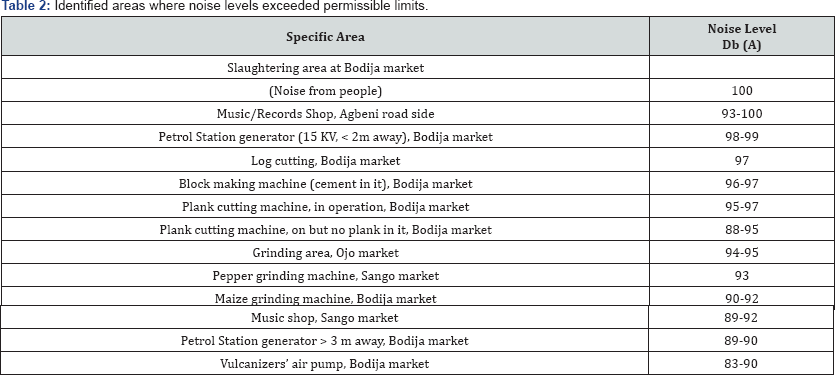Noise Levels in Markets in Ibadan, South West Nigeria- Juniper Publishers
Juniper Publishers- Journal of Civil Engineering
Introduction
Markets in developing countries serve as vital
socioeconomic institutions. Their level of activities often reflects the
prosperity of the country. Ibadan is now regarded as the second largest
city in Black Africa next only to Lagos Metropolis. Much of the
commercial activities in the city take place in the traditional markets
within residential premises. The number of markets in the city have
grown from 26 in 1972, 36 in 1985 and to about 47 by 1994. While these
are well established, there are numerous other sites where selling and
buying take place as the 'Yoruba' ethnic group, which is predominant in
the city, are shrewd traders by tradition. The types of market stalls
vary in Ibadan and they include: covered and lockable stalls, open
stalls, open trading units with tables, and sale 'counters'.
The number of market stalls range from less than 100
(at Ijokodo area), to well over 5000 stalls at Dugbe and Gbagi areas
Vagale [1], Filani & Iyun [2].
The quality of physical environment in the city markets is generally
deplorable with the exception of a few newly built markets. Amenities
such as water supply, toilet facilities and waste disposal are poor but
access by road is reasonably adequate. Most of the major roads are open
to them thereby exposing them to noise and vehicular emissions. Markets
in the indigenous or traditional areas are always crowded and going by
foot is more convenient.
In recent years it is being realized that noise does
not have to be loud to cause health problems. There is increasing
evidence that exposure to relatively low levels of noise for long
periods can affect health, raising blood pressure, disrupting cognitive
development in children, disturbing sleep and prompting psychiatric
disorders Anon [3].
The data on noise levels in Nigerian urban centers is very limited and
no information is available among the markets in particular, which are
wide spread among the residential areas all over the city. This paper
describes noise levels in various markets areas in Ibadan city,
identification of locations where the noise levels are above the
permissible limits, and the activities that contribute to such higher
levels.
Materials and Methods
There are about 47 major markets in Ibadan city. These markets are of five types depending on the time of operation:
a. Morning markets-held between 5.00AM and 12Noon and sell perishable goods such as vegetables and fruits.
b. Day markets most common in Yoruba tradition and
operate between 8AM and 7PM; characterized by very intensive commercial
activities with high density of population, congestion and noise.
c. Night markets - operate between 5PM and 10.00PM
and specialize in selling various cooked foods; urbanization, however,
has drastically reduced these types.
d. Day and Night markets function between 8.00AM and 10.00PM and they deal with a variety of commodities.
e. Periodic markets - held at intervals of 5 to 17
days during daytime; people from various nearby towns come and exhibit
indigenous goods for sale.
Out of these, 22 were selected by random sampling.
Night markets were not included in the study as they mostly deal with
food items. Every market was visited during the peak period between 10
AM and 2 PM on working days. The sound levels were measured using
CEL-269 Digital Integrating Sound Level Meter made in UK by CEL
Instruments. At every point several readings, generally not less than
three were taken and mean values and standard deviations were calculated
before presenting in Tables.
Results
The noise levels in various markets are presented in Table 1.
The results indicate that the lowest mean noise level was 58.7dB in
Railway yard and New Gbagi markets. The highest levels of 100dB at
slaughter slab area of cow section in Bodija market 88.13dB were
recorded in plank section of Bodija market, which and electronic section
of Agbeni market. These two markets are
is the largest in the city. However, the ranges recorded 47dB highly
crowded at all times. The noise was mostly due to chatting as the lowest
at the Cocoa House complex and a maximum of and loud music.


The identified areas where the noise levels are more than the permissible limits are given in Table 2.
The slaughtering area in Bodija market has the highest level followed
by the electronics selling areas in Agbeni. In Bodija, about 300 cows
are manually slaughtered every day from early hours of morning till late
in the afternoon. Here, manual labour is used in bringing the cows to
the place and in the slaughtering process. The sale of electronics and
musicals are generally on the roadside and to attract the passersby, the
traders play loud music. Other areas where the noise levels are above
the permissible limits were woodcutting, block making, grinding, petrol
generators, and vulcanizing areas. The activities that contribute to
higher noise levels are given in Table 3.
Loading, unloading, grinding, cutting, sawing, tailoring, and cement
block making are some of the activities that contribute to higher noise
levels. Noise levels at the access roads and the road junctions are
given in Table 4. The minimum recorded was 53dB and the maximum was 86dB. Some markets particularly [4].




Comments
Post a Comment